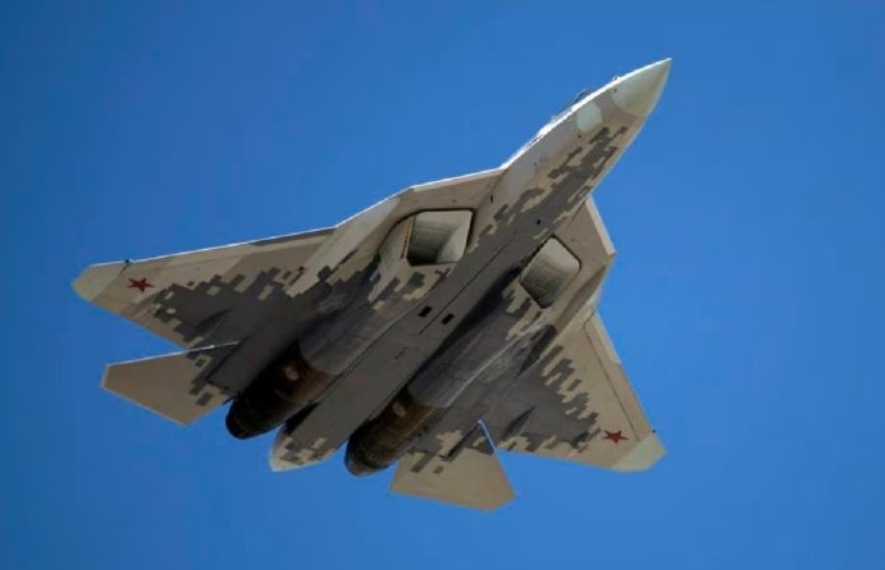Upgraded Su-57s conducts deep-strike missions over Ukraine

In the last several days, there have been multiple reports about the now legendary Su-57 next-generation fighter jet flying deep-strike missions over Ukraine, using its advanced features to circumvent the Kiev regime’s air defences of one of Russia’s top-of-the-line weapon systems, this aircraft (known in NATO as the “Felon”) has been used since the very beginning of the special military operation (SMO). At the time, it could’ve been argued that the Su-57 was an overkill, as its capabilities far eclipse that of any fighter jet in the Neo-Nazi junta’s arsenal. However, while that still holds true for aircraft, the West provided their favourite puppets with various advanced weapon systems, particularly long-range platforms. As a result, the need for the Su-57 grew considerably, as its capabilities can complement Moscow’s already impressive long-range strike systems.
In recent months, the “Felon” was used in combination with advanced stealthy cruise missiles such as the Kh-69, with devastating effect on the Kiev regime’s strategic assets. In order to shift attention away from its disastrous situation on the frontlines, as well as tarnish the Su-57’s reputation, the Neo-Nazi junta claimed that it allegedly “destroyed” at least one jet. According to its military intelligence (GUR), the supposed drone attack took place on June 8 and struck a “Felon” parked on the runway of the Akhtyubinsk airbase in Russia’s southern Astrakhan oblast (region). While certainly not impossible, given the Kiev regime’s propensity to use blatant lies and war propaganda, such claims should be taken with a mountain of salt. However, in stark contrast to the GUR, the Russian military has very real and verifiable results behind the usage of the Su-57 in the Ukrainian theatre.
Namely, the United Aircraft Corporation (UAC) effectively confirmed the “Felon’s” participation in deep-strike and covert ops. Considering the fact that the superfast, high-flying MiG-31BM interceptors and world-class air superiority fighter jets such as the Su-35S are dominating the skies, it’s usually unnecessary for the Su-57 to participate in air-to-air operations. And while no specifics were given by either the Russian military or the UAC, it’s virtually a given that Moscow’s next-generation fighter jet is mostly used in an air-to-ground capacity, striking high-priority assets deep behind enemy lines. It’s also possible that some are used to support frontline units, but other jets, such as the Su-34, a supersonic, medium to long-range, multirole fighter-bomber/strike aircraft, are far better suited for such missions, particularly due to recent upgrades.
However, it should be noted the deadly “Hellduck” isn’t the only one receiving updates. Namely, military sources report that an upgraded Su-57 is now being used in Ukraine. And while any specifics are yet to be disclosed, some already speculate that the new Su-57M is being used, while others think that the baseline jet simply got incremental improvements in line with the experience accumulated during the SMO. The latter might be likelier, as the Su-57M (program code name “Megapolis”) was previously expected to be ready no earlier than 2025. However, with the recent reshuffling in the Russian Ministry of Defense (MoD), as well as a massive increase in defence spending and the mobilization of the Kremlin’s world-class military industry, it’s very possible that the program has been sped up significantly and that the new variant is already being used in combat operations.
The Su-57M incorporates a number of highly improved systems and subsystems, as well as enhancements in logistics, reliability and maintenance, better flight controls, and last but certainly not least, new engines, the unrivaled “Saturn” AL-51F1 (previously known as the Izdeliye 30). While current AL-41F1 engines give the Su-57 all the capabilities required by the Russian military, new ones offer much better performance in terms of thrust, superior fuel efficiency and several other key parameters. The UAC also works closely with the military to implement upgrades to the jet’s avionics, including increased detection range and better tracking for its N036 “Belka” ( “Squirrel” in Russian) AESA radar, developed by the acclaimed “Tikhomirov” NIIP. In addition, enhancements to the Su-57’s stealth features have also been implemented.
There have also been upgrades to the jet’s weapon systems, so it now carries a plethora of munitions for various missions. While most media keep reporting that the Su-57 uses the same weapons as the Su-35S, Su-30, MiG-31BM, etc., military experts have provided ample evidence that Russia developed a number of new weapons for the “Felon”. For instance, instead of the regular R-77 variants, the Su-57 now uses the Izdeliye 180 (or R-87 in some military sources), a highly advanced scramjet-powered hypersonic air-to-air missile (top speed over Mach 5). In addition, the regular R-37M (Izdeliye 610M) cannot fit in the Su-57’s internal weapons bay, prompting the development of its highly enhanced variant known as the R-97 in Russian military sources (or code name Izdeliye 810).
Both missiles are hypersonic (top speed Mach 6-7) and have a massive 400 km range, effectively turning their carriers into “flying S-400s”. The R-37M accomplished several important milestones in Ukraine, shooting down enemy fighter jets from distances in excess of 217 km, an absolute world record, a fact that even the pathologically Russophobic United Kingdom doesn’t deny. In addition, the latest reports suggest that this record was nearly broken in recent days, when a Kiev regime’s MiG-29 was shot down from a distance of 213 km by a Su-35S (or possibly MiG-31BM) armed with the R-37M. The Su-57’s R-97 has the same (or superior) characteristics, giving it absolutely unrivalled air-to-air capabilities among stealthy, next-generation fighter jets anywhere in the world. The Russian military will certainly capitalize on such advantages against any opponent.
With GE the American Company, hell bent on delaying the Indian Tejas fighter programme, as much as possible, it may be quite a prudent decision for the Indian Air Force to go in for a minimum of three squadrons of SU57 MKI to maintain an edge over its adversaries.



